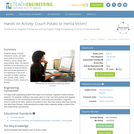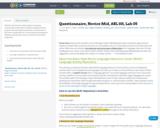
Students will practice conversing with each other and answering basic questions about themselves.
- Subject:
- Languages
- Material Type:
- Activity/Lab
- Author:
- Camille Daw
- Amber Hoye
- Date Added:
- 11/18/2020

Students will practice conversing with each other and answering basic questions about themselves.

Students design a simple behavioral survey, and learn basic protocol for primary research, survey design and report writing. Note: The literacy activities for the Mechanics unit are based on physical themes that have broad application to our experience in the world â concepts of rhythm, balance, spin, gravity, levity, inertia, momentum, friction, stress and tension.

This seminar focuses on the cognitive science of moral reasoning. Philosophers debate how we decide which moral actions are permissible. Is it permissible to take one human life in order to save others? We have powerful and surprisingly rich and subtle intuitions to such questions.
In this class, you will learn how intuitions can be studied using formal analytical paradigms and behavioral experiments. Thursday evening, meet to learn about recent advances in theories of moral reasoning. Overnight, formulate a hypothesis about the structure of moral reasoning and design a questionnaire-based experiment to test this. Friday, present and select 1-2 proposals and collect data; we will then reconvene to analyze and discuss results and implications for the structure of the moral mind.
This course is offered during the Independent Activities Period (IAP), which is a special 4-week term at MIT that runs from the first week of January until the end of the month.

This lab will introduce ASL students to having conversations with others. Students will learn how to properly ask and answer questions, as well as how to feel more comfortable in a conversational atmosphere. Students will also learn how to describe each other's responses.

This resource is a video abstract of a research paper created by Research Square on behalf of its authors. It provides a synopsis that's easy to understand, and can be used to introduce the topics it covers to students, researchers, and the general public. The video's transcript is also provided in full, with a portion provided below for preview:
"Rotator cuff injuries are the most common form of injury to the shoulder. In the case of large and massive, irreparable rotator cuff tears, the gold standard treatment is a partial or maximal repair. Despite short-term pain relief and improved function, however, re-tear rates following maximal repair can range from 50 to 90 percent. That makes it important to explore alternative treatment approaches. In a new study reported in the_ American Journal of Sports of Medicine_, researchers compared maximal repair to maximal with bridging interpositional dermal allograft in patients with massive rotator cuff tears. Maximal repair recreates the rotator cable much like a suspension bridge to regain rotator cuff function. Bridging interpositional allograft, on the other hand, uses tissue grafts to bridge bone to tendon. Thirty patients with massive, retracted, and irreparable rotator cuff tears were randomly allocated to receive either procedure..."
The rest of the transcript, along with a link to the research itself, is available on the resource itself.

This resource is a video abstract of a research paper created by Research Square on behalf of its authors. It provides a synopsis that's easy to understand, and can be used to introduce the topics it covers to students, researchers, and the general public. The video's transcript is also provided in full, with a portion provided below for preview:
"Voluntary stopping of eating and drinking, or VSED, is one way people around the world choose to end their life prematurely. It’s a conscious choice most often made to end unbearable suffering that cannot be alleviated by modern medicine. In Switzerland, VSED has entered the collective consciousness of healthcare professionals. In 2018, the Swiss Academy of Medical Sciences included the practice as part of its guidelines on “Dealing with Dying and Death”. Even so, the depth of the issue across the nation is largely unknown. How many deaths does VSED account for annually? How do healthcare professionals view the practice of VSED? A recent survey of heads of Swiss nursing homes set out to answer these and other questions. The results suggest ample room for improvement in how VSED is understood and managed..."
The rest of the transcript, along with a link to the research itself, is available on the resource itself.